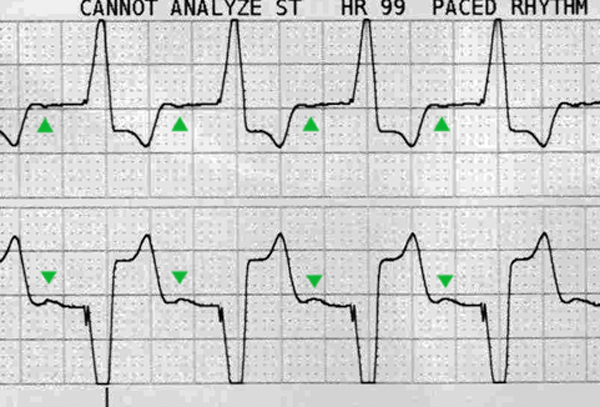A-sensed V-paced rhythm
First Glance:
From across the room it looks like a paced rhythm on the fast side.
Discussion:
Right off the bat, we see wide bizarre complexes consistent with a ventricular rhythm, and when we look closely we see regular very narrow spikes immediately before every QRS. These are pacer spikes.
You might wonder who would set a pacer to run the heart at 100 bpm. Can you see who set the rhythm?

It looks like the patient did! We see regular P waves in both leads. Negative in AVL (normal) and positive in III (normal). So this looks like a sinus tachycardia, and the pacer is tracking the P waves. This regular rhythm can be due to two pacer modes. The simplistic one is that the pacer robotically fires the ventricle lead a set interval after every atrial event. This is old school. The more likely mode is that the pacer is listening to the ventricle lead for a conducted beat. When nothing comes down the pipe after a suitable interval, it fires it’s own ventricular beat- a sort of ventricular escape that is timed to optimize the use of the atrial kick.
Every pacer spike is followed by a QRS, so there is 100% capture.
We can also see ST elevation, which while expected in a paced rhythm is impressive here. If we take Sgarbossa’s (very soft) criteria for EKG signs suggestive of ischemia in the paced rhythm, this easily meets it. In III we see 5mm of ST elevation at 50% gain, which means this would be 10mm of ST elevation at standard voltage calibration- well above the 5mm cutoff.
Final Impression?
Sinus tachycardia @ ~100bpm with atrial-sensed ventricular-paced rhythm with 100% capture, concerning for ischemia.
Management implications:
Get a 12l to evaluate properly for ischemia/infarction. Given the poor sensitivity and specificity of ST elevation in paced rhythms, a solid history and cardiac enzymes will be more important than usual in the management discussion.
The pacer appears to be working well.
The Take-home Point:
Most ventricular pacer leads screw into the apex of the right ventricle. Therefore, when the pacer fires the ventricle, the depolarization wave propagates from the RV to the LV. The LV is fired second, from slow myocardial conduction. It should come as no surprise then that most paced rhythms show QRS morphology that looks like a LBBB.
However, while Sgarbossa’s criteria are often discussed in the setting of LBBB, for some reason they are considered less useful in the paced rhythm- possibly because that was not their original diagnostic intention, and because a paced LBBBoid pattern is not a true LBBB. Someone who knows more about this than I do might elaborate.
For what it’s worth though, there are folks who consider them useful. See for example this recent study suggesting good specificity for AMI in paced rhythms with >5mm discordant ST elevation.
To take this even further, there is a paper in Annals of Em Med from late 2012 (incidentally with lead author Dr. Smith who has his own excellent ECG blog). He evaluated a modified Sgarbossa algorithm which replaced the 5mm rule with a ratio of ST:S. Basically, his team found increased specificity with the modified rule, where if the major deflection of the QRS is less than four times the discordant ST segment deflection it is consistent with MI. Here’s the link to that paper.
![]() Two star strip. The meat and potatoes.
Two star strip. The meat and potatoes.
